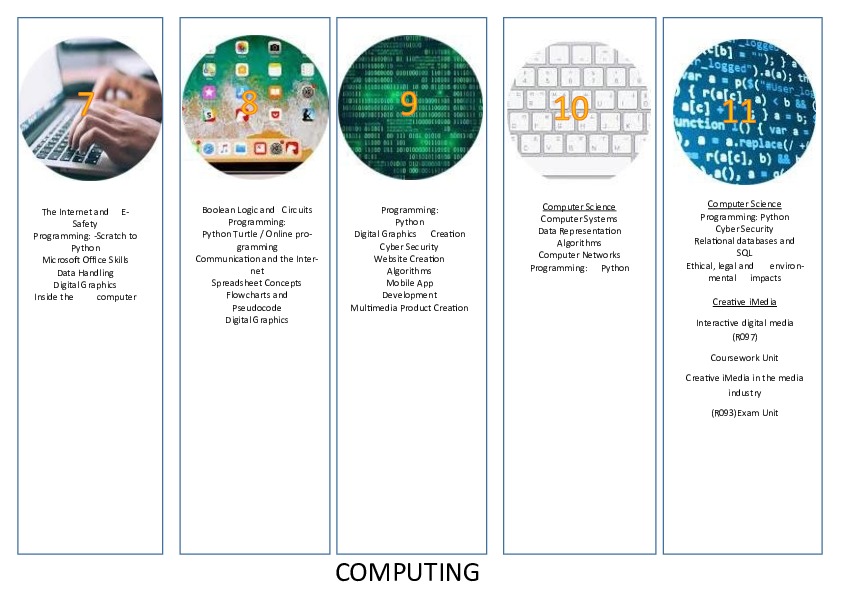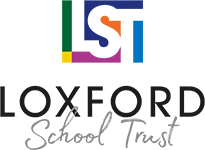- Home
- Secondary
- Subject Information
Computing
Back
Introduction
A high-quality computing education equips pupils to use computational thinking and creativity to understand and change the world. Computing also ensures that pupils become digitally literate – able to use, and express themselves and develop their ideas through information technology.
Our subject area seeks to develop the following in all our students:
- All pupils can understand and apply the fundamental principles and concepts of computer science, including abstraction, logic, algorithms and data representation.
- All pupils can analyse problems in computational terms, and have repeated practical experience of writing computer programs in order to solve such problems
- All pupils can evaluate and apply information technology, including new or unfamiliar technologies, analytically to solve problems
- All pupils are responsible, competent, confident and creative users of information and communication technology
KS3
The KS3 curriculum covers all of the exciting facets from the Computing National Curriculum. These include topics covering basic ICT skills, Digital Literacy and Computer Science.
Each half term pupils will complete a new unit of work using different industry standard software and on this software learn a range of different skills to solve a variety of different problems.
The curriculum that is covered through-out these units introduces our students to a variety of subject skills using various programming languages, and sequencing tools. The students also learn binary, binary addition and working in base 2 and 16. We challenge our students to solve logical problems using standard practice.
The curriculum is structured to offer our students the best learning experience and to enthuse them with a passion for computing, to give them the best experience, and to be able to make an informed choice when they pick their optional GCSE's.
Areas of study covered in KS3:
Year 7
- The Internet and E-Safety
- Programming: Scratch to Python
- Microsoft Office Skills
- Data Handling
- Digital Graphics
- Inside the Computer
Year 8
- Boolean Logic and Circuits
- Programming: Python Turtle / Online programming
- Communication and The Internet
- Spreadsheet Concepts
- Flowcharts and Pseudocode
- Digital Graphics
Year 9
- Programming: Python
- Graphics Creation
- Cyber Security
- Website Creation
- Mobile App Development
- Multimedia Product Creation
Homework expectations (hours and completion standards):
The types of homework set include research activities, focussed tasks, question and answer exercises. (30 minutes a fortnight). All homework is posted on Google Classroom and is recoded in pupil planners to inform parents of the tasks required and the deadline.
Out of class opportunities (Clubs):
Computing Club takes place once a week: Friday 3:10 – 4:10
Assessments
Through-out KS3 assessments in Computing are carried out on a half-termly basis. Assessments cover a range of formats from written papers to practical tasks, this is down so that all KS3 pupils will have experienced the type of assessments they may need to complete if they chose to follow a KS4 course in Computer Science.
Online Resources
The department extensively uses Google resources to support learning both in the classroom and at home. This is predominately done through Google Classroom but also includes the use of Google docs, sheets, presentations and sites.
We also use a range a sites such as:
Computing Facilities
The department has access to 4 computer rooms each with 30 computers. All rooms have been recently updated to Windows 11. Each computer has Microsoft Office, Python 3 / Pygame, Flowol, Scratch and Inkscape.
How can I support my child at home?
The world of Computing is constantly moving on and it is always helpful to try to keep up to date with the latest exciting developments. On the BBC website there are lots of short video clips in the Technology area of the News section, including the weekly “Click” update.
Regular practice with software is a good idea and the open source software listed on this page is free to download, with lots of online tutorials available.
KS4
Students have the opportunity to study aspects of information technology and computer science at sufficient depth to allow them to progress to higher levels of study or to a professional career. Students are taught to develop their capability, creativity and knowledge in digital media and information technology. They develop and apply their analytic, problem-solving, design, and computational thinking skills understand how technology impacts society.
GCSE Computer Science
Computer technology continues to advance rapidly and the way that technology is consumed has also been changing at a fast pace over recent years. The growth in the use of mobile devices and web-related technologies has exploded, resulting in new challenges for employers and employees. For example, businesses today require an ever-increasing number of technologically-aware individuals. This is even more so in the gaming, mobile and web related industries and this specification has been designed with this in mind.
Specification details:
AQA: GCSE Computer Science
Course component breakdown
Paper 1: Computational Thinking and Programming
Written Exam: 2 hours (50%)
A mix of multiple choice, short answer and longer answer questions assessing programming, practical problem-solving and computational thinking skills.
What’s assessed?
- Fundamentals of algorithms
- Programming
Paper 2: Computing Concepts
Written Exam: 1 hour and 45 minutes (50%)
A mix of multiple choice, short answer, longer answer and extended response questions assessing SQL programming skills and theoretical knowledge
What’s assessed?
- Fundamentals of data representation
- Computer systems
- Fundamentals of computer networks
- Cyber Security
- Relational databases and structured query language (SQL)
- Ethical, legal and environmental impacts of digital technology on wider society, including issues of privacy
Homework expectations (hours and completion standards)
Homework for this course involves independent research projects designed to deepen students' knowledge and enjoyment of the topics studied. (30 minutes a week)
How can I boost my child’s GCSE grade?
If you encourage your child to do the following then it will help them achieve a better grade in Computer Science:
- Attendance and Punctuality.
- Maximum effort in lesson.
- Do your homework. (Set on Google Classroom)
- Use YouTube Video tutorials to continuously revise topics that you have covered in class.
- Practice Programming skills. Outside of lessons practice the programming skills learnt in lessons.
How can I support my child at home?
Parents and carers can support their children studying the course by encouraging the application of the more practical aspects of the syllabus.
Recommended GCSE websites:
- https://www.aqa.org.uk/subjects/computer-science/gcse/computer-science-8525/specification
- https://www.bbc.co.uk/bitesize/examspecs/zkwsjhv
- https://www.teach-ict.com/v/GCSE_Computing/AQA_8525/aqa_8525_home.html
Recommended GCSE texts or revision guides:
AQA GCSE Computer Science Student's Book
My Revision Notes AQA GCSE Computer Science Computing Fundamentals
Visual Curriculum Map
Creative iMedia
Cambridge Nationals in Creative iMedia are media sector-focused, including film, television, web development, gaming and animation, and have IT at their heart. They provide knowledge in a number of key areas in this field from pre-production skills to digital animation and have a motivating, hands-on approach to both teaching and learning. Cambridge Nationals deliver skills across the whole range of learning styles and abilities, effectively engaging and inspiring all students to achieve great things.
Cambridge Nationals deliver the essential skills required in employment. It is suitable across the whole range of learning styles and abilities, effectively engaging and inspiring all students to achieve great things.
Specification details (web address)
Cambridge National Certificate in Creative iMedia (Level 1/2)
https://www.ocr.org.uk/qualifications/cambridge-nationals/creative-imedia-level-1-2-j834/
Course component breakdown
Unit R093: Creative iMedia in the media industry
1hour 30 minutes exam paper externally set and assessed. (40%) Mandatory
In this unit, students will learn about the sectors, products and job roles that form the media industry. They will learn the legal and ethical issues considered and the processes used to plan and create digital media products. They will learn how media codes are used within the creation of media products to convey meaning, create impact and engage audiences. They will learn to choose the most appropriate format and properties for different media products.
Completing this unit will provide students with the basic skills for further study or a range of creative job roles within the media industry.
- Topic area 1: The media industry
- Topic area 2: Factors influencing product design
- Topic area 3: Pre-production planning
- Topic area 4: Distribution considerations
Unit R094: Visual identity and digital graphics
NEA (25%) Mandatory
In this unit, students will learn how to develop visual identities for clients. They will also learn to apply the concepts of graphic design to create original digital graphics which incorporate their visual identity to engage a target audience.
Completing this unit will introduce the foundations for further study or a wide range of job roles within the media industry.
- Topic area 1: Develop visual identity
- Topic area 2: Plan digital graphics for products
- Topic area 3: Create visual identity and digital graphics
Unit R097: Interactive digital media
NEA (35%) Optional
In this unit, students will learn to design and create interactive digital media products for chosen platforms. They will learn to select, edit and repurpose multimedia content of different kinds and create the structure and interactive elements necessary for an effective user experience.
Completing this unit will provide students with the basic skills for further study or a range of creative and technical job roles within the media industry.
- Topic area 1: Plan interactive digital media
- Topic area 2: Create interactive digital media
- Topic area 3: Review interactive digital media
All course work units are internally assessed and externally moderated. (60% in total)
Homework expectations (hours and completion standards)
Students are set homework tasks that are designed to supplement and extend topics explored in the course. (30 minutes per week)
How can I boost my child’s GCSE grade?
If you encourage your child to do the following then it will help them achieve a better grade in Creative iMedia:
- Attendance and Punctuality.
- Maximum effort in lesson.
- Do your homework. (Use Google Classroom)
- Practice software skills. Outside of lessons practice using the software skills learnt in lessons.
How can I support my child at home?
Parents and carers can support their children studying the course by encouraging the application of the more practical aspects of the syllabus.
Recommended GCSE websites:https://www.ocr.org.uk/qualifications/cambridge-nationals/creative-imedia-level-1-2-j834/
Recommended GCSE texts or revision guides:
My Revision Notes: Level 1/Level 2 Cambridge National in Creative iMedia: Second Edition
ClearRevise OCR iMedia J834: llustrated revision and practice
How can I support my child at home?
The world of Computing is constantly moving on and it is always helpful to try to keep up to date with the latest exciting developments. On the BBC website there are lots of short video clips in the Technology area of the News section, including the weekly “Click” update.
Regular practice with software is a good idea and the open source software listed on this page is free to download, with lots of online tutorials available.



